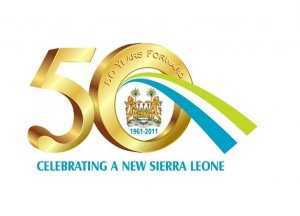
Sierra Leone gained independence from Britain on 27th April 1961. This Golden Jubilee has attracted many Sierra Leoneans, including Christians who take a look at the Bible to bring out the meaning of Jubilee, a period of relative freedom and rest, redemption of the land, the accumulation of property etc. It was Winston Churchill who once noted that ‘the farther backward one goes, the farther forward he could see’. The church has played a very important role in the development of the Province of Freedom and must revamp its interest in education to regain its adored place in society.
Should we celebrate 50 years of independence?
At 11:55 p.m. on 26th April 1961, the Union Jack (the flag of Britain) was lowered in the midst of a dark background with only a dim light penetrating on the flag as it came down. By the time the green, white and blue horizontal stripes (Sierra Leone’s national flag) was hoisted, it was the dawn of a new ear – 27th April 1961. When Clifford Fyle composed the National Anthem, the very first line describes Sierra Leone as the ‘realm of the free’. The date 27th April was a deliberate choice since it was the very date that the Hut Tax War started in 1898. This demonstration was managed by Bai Bureh/Kebalai who wanted his people to be free.
As Sierra Leoneans take a look back over the last fifty years, they could easily identify the good, bad and ugly. This has led to a thorny debate in the nation. Should we celebrate 50 years of independence? That is the question. Some say no and others respond in the affirmative. Since people are generally the product of their social or economic class, ethnicity, gender, upbringing and paradoxically biases and interests, these factors and others could colour the conclusions to which they come. Whatever may be the opinions of people, it is evident that the nation would need to take stock of its strengths, weaknesses, opportunities and threats. It would be meaningless to repeat past errors. They must be corrected and an area for the church is to revamp its commitment to quality education.
Meaning of Jubilee in the context of Christianity
Lev. 25 specifically paints the picture of the importance of the fiftieth year in the lives of the Jews. This is the equivalent of seven Sabbath years (a total of forty nine years) plus a year. The fiftieth year, among other things should be one of rest; a period when land is restored and slaves are free and when people eat what was planted the year. This is a time to revamp the ideals of freedom that the Abolitionists (Granville Sharpe, Williams Wilberforce, Thomas Clarkson and others) had for the African.
Province of Freedom/Granville Town/Establishment of the colony in Sierra Leone
Sierra Leone did not receive the name ‘Province of Freedom’ by chance. When Lord Chief Justice Mansfield declared slavery illegal in Britain in 1772, every slave who managed to set foot on British soil eventually became free. The number of freed slaves in Britain increased after the British lost the American War of Independence won by the thirteen colonies. The slaves who fought on the side of Britain were promised freedom and land for their services. They joined their ‘brethren’ when the war ended in 1783 and the increased number of slaves soon posed a social problem. Freedom never meant equality with the British citizens and they suffered discrimination. Many lived by begging and some were thieves. Britain started looking for ways to end this social menace caused by the Black Poor, a generic name given to these Africans who came from diverse cultural backgrounds. This degrading name was also self-explanatory since they were blacks who were poor.
A botanist, Dr. Henry Smeathman, who was then working around modern day Sierra Leone provided an opportunity that the Abolitionists grabbed passionately. He recommended Sierra Leone as an area of immense fertility. His flowering description of this fertile land which could be inhabited was accepted by Abolitionists who could have acted on their own but for limited funds. They approached the British government for help to send the Black Poor to Sierra Leone, a request that was immediately honoured since the government wanted to end the social menace cause by the Black Poor.
In April 1787, about 411 (including some white prostitutes) under the command of Captain Thompson sailed to Sierra Leone and arrived during the rainy season in May 1787 under the auspices of the Committee for the Relief of the Black Poor formed by Granville Sharpe. The settlement was called Province of Freedom because it made provision for those who were free including ownership of land (though not the exact amount promised). It was also named ‘Granville Town’ in honour of Granville Sharpe’s contribution to their welfare and resettlement. The first governor of the Province of Freedom in 1787 was an African, Richard Weaver. It was indeed the realm of the free.
Freetown
It was rather unfortunate that Granville Town/Province of Freedom was burnt down by King Jimmy in 1789. There were disagreements between the British and the Temne over the ownership of land. Arrangements were made with the Koya Temne subchief, King Tom and regent Naimbana. The earlier believed that the ‘payment’ made in 1787 was a one time affair but land is viewed as communal property by the latter who did expect periodic rent. King Jimmy who succeeded King Tom therefore burnt down the settlement when disputes broke out.
The destruction of the settlement however did not end the dream/vision of the Abolitionists who started working on plans to rebuild Granville Town. The initial move made was to send Alexander Falconbrige to Sierra Leone and he gathered the remaining Black Poor in 1791. Some of the slaves who fought in the American War of Independence went to Canada and 1190 of them travelled to Sierra Leone directly from Nova Scotia in 1792. This group started Freetown, the current capital of Sierra Leone. Again, it was the realm of the free.
Christian missionary activity intensified in the colony as a result of the presence of the settlers. It is worth noting that there were three different sets of Christian denominations among the Nova Scotians. These included the Methodists, Countess of Huntingdon Connexion and Baptists. They praised God under the well-known Cotton Tree in Freetown.
The church and education in ‘Athens of West Africa’
Sierra Leone was simply ‘primus inter pares’, first among equals in the nineteenth century. Christian missionary bodies were very instrumental in Freetown. The country produced the first set of educated elite in the sub-region as a result of the educational institutions opened by various denominations. Examples include:
Educational institution Denomination Year
Fourah Bay College Anglican 1827
Sierra Leone Grammar School Anglican 1845
The Annie Walsh Memorial School Anglican 1849
St. Joseph Catholics 1866
Methodist Boys’ High School Methodists| 1874
Methodist Girl’s High School Methodists| 1880
The Albert Academy United Brethren in Christ 1904
It is incredible to note that all principals of Fourah Bay College between its inception in 1827 and 1948 were ordained ministers of religion. The church should revamp its role in education as the Bible encourages one not to remove the ancient land mark.
Generally, there was an existence of several educational institutions which provided training not only for inhabitants of Sierra Leone but also those in other West African countries. Freetown was to West Africa just what Athens was to the ancient Greeks. As the leading area for western education, it realistically earned the name ‘Athens of West Africa’.
Antioch of West Africa: Sierra Leone’s role in religion
The disciples were first called Christians in Acts 11:26. The followers of Jesus Christ were first called Christians as a result of their Christ-like behaviour. Freetown could reasonably be called the Antioch of West Africa because of its pioneer role in propagating the Christian gospel. The Church Missionary Society (CMS) for instance was founded in 1799 and became the missionary arm of the Church of England with Sierra Leone as its first mission field. All the denominations listed in the previous section built churches in the nineteenth century which are still in existence in the present generation.
Conclusion
This focus of this reflection is on the role of the church in the area of education which must be revamped. Is it a surprise that the Sierra Leone Grammar School in particular had been pronounced as the best school for the last two years? Is it a surprise that the current principal of the school, Mr. Akiwande Josiah Lasite (whose sacrificial service started in 1971) recently won the Integrity Award by the Anti Corruption Commission? The school has once again gone under the direct control of the Anglican church.
AUTOPOST by BEDEWY VISIT GAHZLY


